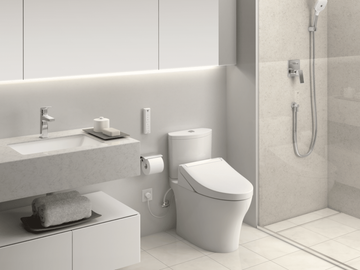Choosing the right tile for your bathroom floor is pivotal. Not only does it influence the bathroom's aesthetic, but it also affects safety and maintenance. So, what kind of tile is best for bathroom floor? In this article, we will delve into various tile types, their benefits, drawbacks, and what to consider while making your choice.
Bathrooms require materials designed to withstand humidity and moisture. Hence, the ideal tiles need to be water-resistant and durable. Initially, it might seem overwhelming due to the plethora of options available. This guide will help you understand which tiles are not only appealing but also practical for your bathroom.

Understanding Different Types of Tiles
First, let's explore some of the notable options available for bathroom flooring tiles. Understanding these types is crucial for making an informed decision.
Ceramic Tiles
Ceramic tiles are among the most common choices for bathroom flooring. They are made from clay and are baked at high temperatures, making them durable and moisture-resistant. Additionally, they come in various designs, colors, and sizes, providing versatility.
However, one should note that ceramic tiles can be slippery when wet. For added safety, consider opting for textured ceramic tiles or applying non-slip coatings.
Porcelain Tiles
Porcelain tiles are another remarkable choice for bathroom floors. They are similar to ceramic tiles but denser and less porous, making them even more water-resistant. Porcelain is an excellent option for those living in areas with fluctuating temperatures, as they are less prone to cracking.
If looking for an overwhelming variety in design, porcelain tiles offer stunning visuals that mimic natural stone. For guidance on installation, refer to how to tile a bathroom.
Vinyl Tiles
Vinyl tiles are an economical and versatile option. They offer comfort underfoot and are easy to install. Modern vinyl tiles come in designs that closely replicate wood or stone, enhancing the bathroom's visual appeal.
Moreover, vinyl tiles are resistant to water, making them ideal for bathrooms. However, homeowners should be cautious, as cheaper options may not last as long and could wear out faster.
Natural Stone Tiles
Natural stone tiles, such as marble, granite, or slate, bring an exquisite look to your bathroom. Their unique textures and colors elevate the bathroom design remarkably. Nevertheless, natural stone requires sealing to prevent moisture absorption and staining.
This means constant maintenance is vital, which could be a deterrent for some. On the other hand, natural stone is undeniably a luxurious option and can increase your propertys market value.
Key Factors to Consider When Choosing Bathroom Tile
While the type of tile is of obvious importance, several critical factors should influence your decision.
Slip Resistance
In a bathroom, where wet conditions are inevitable, slip resistance is crucial. Always check the coefficient of friction (COF) rating for tiles. A higher rating indicates better slip resistance. Opt for options with textured surfaces or dedicated non-slip varieties.
Water Absorption Rate
Tiles have different water absorption rates, which are vital for usability in a bathroom. Low porosity tiles, such as porcelain, can withstand water better than higher porosity alternatives. Always opt for tiles with a low water absorption rate to minimize damage and maintenance.
Durability
Not all tiles are created equal. This is where factors such as hardness and durability come into play. Floor tiles often take a beating due to foot traffic, making it essential to select a durable option. Porcelain and natural stone tiles generally offer better durability than traditional ceramic tiles.
Maintenance Requirements
Some tiles demand more maintenance than others. Natural stone tiles require sealing, while vinyl tiles often necessitate minimal care. If you're someone who prefers easy upkeep, opt for tiles that are straightforward to clean and maintain.
Current Trends in Bathroom Tiles
Tile trends can often influence what kind of tile is best for bathroom floor. Here are some current trends that are shaping the marketplace:
Larger Format Tiles
Larger tiles minimize grout lines, creating a cleaner look in the bathroom. In addition to aesthetics, they can cut down on cleaning time, making them a preferred choice.
Bold Patterns and Colors
Daring and intricate designs are becoming popular, moving away from traditional solid colors. If aiming for a unique bathroom, embracing patterned tiles can add a personalized touch.
Eco-Friendly Options
With the rise of environmentally conscious customers, eco-friendly tile options are gaining traction. Many companies now produce tiles made from recycled materials that uphold both durability and style.
Cost Considerations
Typically, the cost of the tile varies according to the type and brand. While some may come off as budget-friendly, others like natural stone can be relatively expensive. Consider both the immediate cost and the long-term value of the investment. Research pricing and find tile options that meet your budget and satisfaction levels.
For more on cost-effective bathroom flooring choices, feel free to visit the tile tips guide.
Conclusion
The bathroom floor is one of the most significant aspects of bathroom design and functionality. Understanding the importance of various types of tiles and considering factors such as slip resistance, durability, and maintenance can steer you toward the right decision. Many options can suit various styles and budgets, but the right choice aligns with both your aesthetic or practical needs.

FAQ
1. What type of tile is best for a small bathroom?
Opt for light colors and larger format tiles to create an illusion of spaciousness.
2. Are vinyl tiles a good choice for bathrooms?
Yes, vinyl tiles are a cost-effective and water-resistant option suitable for bathroom flooring.
3. How often should I clean my bathroom tiles?
Regularly clean your tiles at least once a week to prevent mold and ensure their longevity.
As an Amazon Associate, I earn from qualifying purchases.






